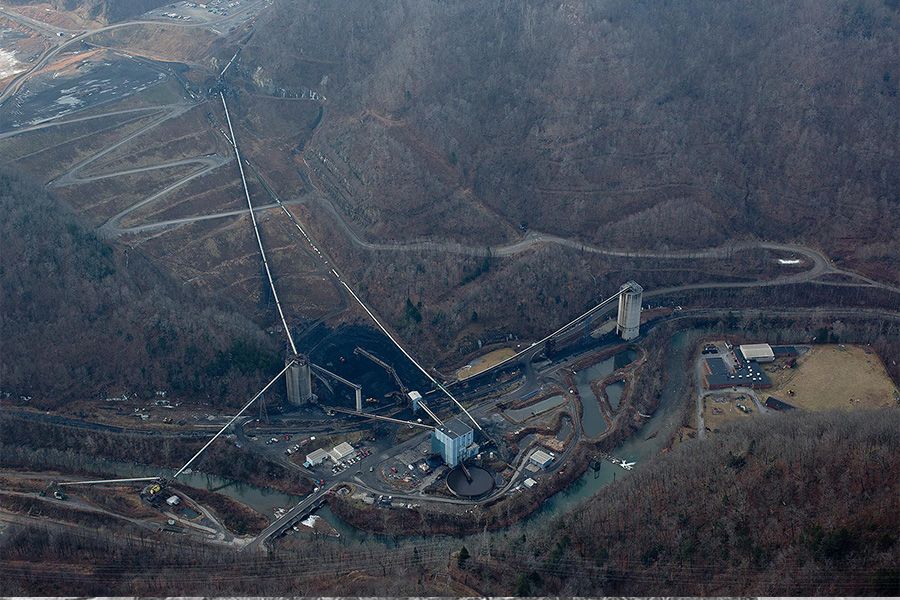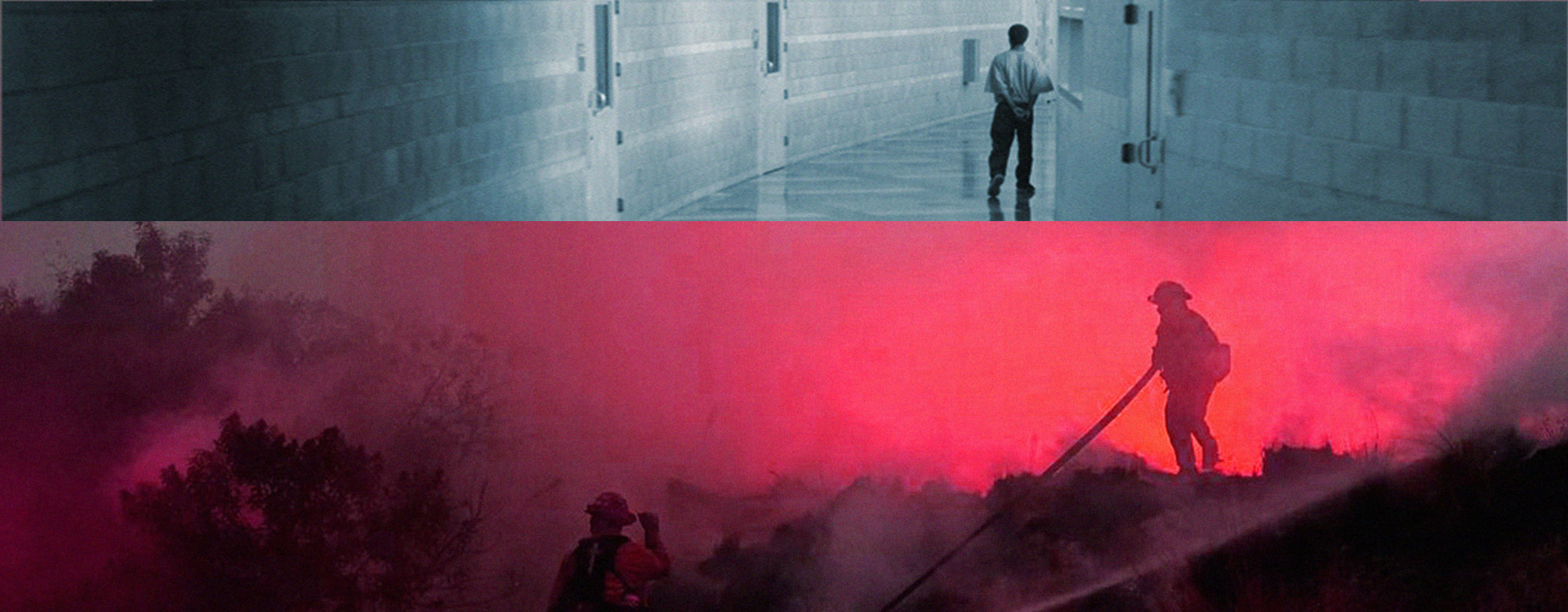Two new books take the real measure of American carnage.
From the mountaintops of Whitesville, West Virginia you can see clearly the landscape of the extractive economy. A giant network of beltways cuts through and rumbles over the hillsides, with conveyors carrying newly mined coal out to the processing plants that dot the side of every passable road. If you stood over the valley in the spring of 2016, you would have seen the Coal River licking aggressively at its edges, threatening to burst again over its banks after weeks of historic rainfall. A ways down the mountain, in the small towns, you wouldn’t have heard much talk about the looming presidential election, but you would have heard a lot of people worrying about food, drinkable water, and rent. They would have worried about the landslides, too—caused by flooded hillsides eroded by mountaintop removal practices—that were backing up coal trucks and pickups alike for miles down the mountains. Landslides would have made travel to a nearby memorial to dead coal miners impossible, but anyone looking for reminders of mortality wouldn’t have had to go far: in nearby Huntington, WV, the local emergency room was dealing with a dozen or so opioid overdoses every day, a phenomenon so common that two years later the city had to admit it was struggling even to bury the indigent.
The struggle for survival, ecological devastation, lack of faith in party politics, and despair at ever-downward mobility visible from those mountaintops are also the themes of Phillip Neel’s Hinterland: America’s New Landscape of Class and Conflict. Neel’s idea of the “hinterland” is one of those wonderfully, frustratingly baggy Marxist categories, describing migrant worker camps in southern China, the banlieues and council estates of Europe, the poor black and white suburbs like Ferguson, Missouri, and the rural regions of the Pacific Northwest where more and more people depend on catastrophe employment like firefighting and flood prevention. These disparate places are all low output and often low population, the “hidden abodes” of deindustrialization that have experienced all of the toxicity and none of the promise of late capitalism—in Neel’s analysis, a single, massive periphery conditioned by a cocktail of “sorrow, apathy, and rage.” In the far hinterlands of the American West, the dominant response is a far-right rejection of liberalism and of federal control over land, as well as the rise of a shadow economy of methamphetamine, firefighting, and the ad-hoc labor of hunting, fishing, and trapping. In the riotous near hinterland of Ferguson, the nature and purpose of the police project to contain the un- and under-employed by way of racialized violence becomes clear, as do the possibilities for popular resistance in the cul-de-sacs of suburbs where such insurrection was once unthinkable. Although Neel says less about them, in the hinterlands of central Extractive Appalachia after the loss of coal-tax revenue the recipe would also include opioids, the prison industry, and contract labor for resource extraction.
There is much to praise about Hinterland, including that it is beautifully written. Neel contributes to a long tradition, going back to Malthus and Smith as well as to Marx, of representing both economic growth and stagnation in the language of the organic. He attends to the destruction of the land—from the fires and floods that are remaking the West to the fertilizer-soaked fields of China’s industrial agriculture zones—and also to the vulnerability of the body, which is depleted by the material and affective anguish of being under-employed and over-policed but finds succor in a range of communitarian movements, from ultra-left to far-right. This is a book about both circulation and stagnation: material resources (and cultural and intellectual attention) move as if by force of nature into the higher-output urban and affluent suburban core, while isolation, suffering, and apathy fester and rot in the hinterlands.

Hinterland is most useful when read as a rejoinder to the dominant narratives—“tax collector journalism,” in Neel’s cutting phrase—of the present political moment. In Neel’s formulation, the rural white residents of the far hinterlands tend to find “more promise in opiates than politics.” He refuses the breathless condemnations of urban liberal commentators who credit rural voters with the rise of right-wing and white-identitarian politics. For Neel, participation in these movements is less about ideology and more about survival: “support follows strength,” he writes, “and belief trails far behind.” To the extent that Neel discerns a radical politics in the present, his commitments lie with insurrections and riots—with what he calls (with mordant irony) the Party of Anarchy and with all those who seek to develop on-the-ground forms of dual or concrete power in opposition to the state, whether by finding means of reproduction outside the market or by advancing and defending moments of local struggle. His argument that groups like the Patriot Movement are motivated primarily by anti-statism—particularly by a resistance to federal land management—rather than by racial supremacy is provocative, but often seems to ignore the ways in which the recent resurgence of the “alt-right” has helped fortify an increasingly strong state apparatus marshaled against both immigration and anti-cop insurgency. Indeed, while Neel cogently rejects urban white liberals’ assumptions about the redneck racism of hinterlanders, his book is weakest on issues of race. Claims that the urban poor and non-white migrants receive more social welfare provisions than do the rural working class, or that African-American households experienced meaningful gains in the post-Civil Rights era, are woefully familiar as the defensive posture taken by other recent critiques of so-called identity politics.
To better ascertain the meeting of capitalism and racialization, then, one might turn to another recent attempt to develop an epoch-making concept of the political now, Jackie Wang’s Carceral Capitalism. Wang’s book, like Neel’s, combines scholarly insight with radical politics and with a personal, and often lyrical, rhetorical style. Whereas Neel’s central concept is spatial, Wang’s is historical. Her idea of “carceral capitalism” describes a modern “predatory state” that uses both direct violence—policing and incarceration—and indirect means like debt to manage intensifying crises in wages, housing, employment, and social provisioning. In so doing, Carceral Capitalism offers an imaginative record of the “racial capitalism” (in Cedric Robinson’s famous phrase) of the present. Moving through chapters on debt, the juvenile justice system, and policing, Wang lays out a poetic synthesis of Afro-pessimism, abolitionist visions, and a Foucauldian reading of the relation between capitalism and the technologies of incarceration. Her analysis sometimes verges on the overly scholastic, but when the book’s claims are more grounded, as in an excellent chapter on the practice of “taxation by citation” and the murder of Michael Brown, her account of the relationship between racialization, police power, and the collapse of productive investment is both urgent and persuasive. Like Neel, Wang is committed to offering a thick description of futurelessness: what it means to be unable to walk down the street without fear of cops, what it means to be trapped in debt, what it means to live under a life sentence.
“During massive wildfires this past summer, the state of California called on the labor of more than two thousand “volunteer” inmate firefighters, including sixty juveniles.”
The interdisciplinarity of Carceral Capitalism seems necessary given its concerns but is also often the book’s weakness, especially when Wang engages questions of prison abolition and policing with scant reference either to contemporary scholarship or to the long theoretical tradition on abolition (from writers such as Angela Davis or Thomas Mathieson, or activist organizations like Critical Resistance, to name but a few among the many to have offered fully articulated visions of the abolitionist imagination). At times, Carceral Capitalism’s abolition is more poetic than programmatic—not necessarily a weakness, but a tendency that sometimes finds the book unmoored from the kind of on-the-ground activist work being done to challenge incarceration and policing as such. Wang takes aim at data-driven predictive policing, for instance, and offers some fascinating investigative notes on key technologies. Her claim that they mark a fundamental shift in the logic or the purpose of policing, however, risks being mistaken for a critique only of particular practices—algorithmic policing, or stop-and-frisk—rather than a call for police abolition. Before screens flickered with data in the basements of contemporary police headquarters, police power was exercised most intensely along the lines of what police knew and still know: how to enforce and maintain racial segregation and property rights in those spaces where they are most likely to be challenged. Police militarization likewise makes its requisite appearances, but Wang fails to make clear that shared technologies, tactics, strategies, and missions have always entwined the police power with military power.
Wang does offer an illuminating account of new practices in juvenile detention and sentencing; her own older brother was given a sentence of Juvenile Life Without Parole, and she writes movingly about what it was like to witness the destruction of his life that followed from his sentencing and incarceration. Reading these pages with Hinterland in mind, one might well think of still more mountainsides, those of California’s Coast and Sierra Nevada ranges. During massive wildfires this past summer, the state of California called on the labor of more than two thousand “volunteer” inmate firefighters, including sixty juveniles. They were paid a dollar an hour; two imprisoned men, both in their early twenties, died while fighting fires in 2017 and another was killed in 2018. They were not eligible for death benefits. Although the practice of using prison labor to fight fires dates back to World War II, its use today is unprecedented, with imprisoned people making up a third of California’s ever-growing wildfire fighting force. Here we see, with blazing clarity, both the violence of a predatory state dependent on incarceration to manage everything from municipal budgets to surplus populations, and the material consequences of a long and ongoing stagnation in capitalist accumulation, one whose effects will be ecological as well as political. What is clear, in both Hinterland and Carceral Capitalism, is that from the scorched forests of the Northwest to the skittering Molotovs of Ferguson, from the carceral geographies of the global prison boom to the exploding meth labs and opioid overdoses of Appalachia, the history of the present is being written in blood and fire.





